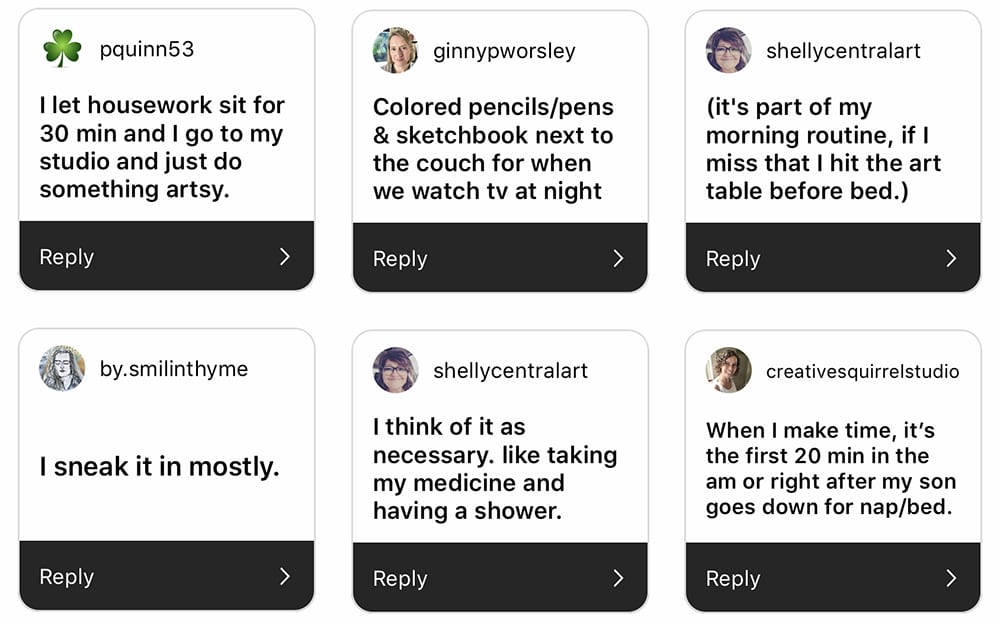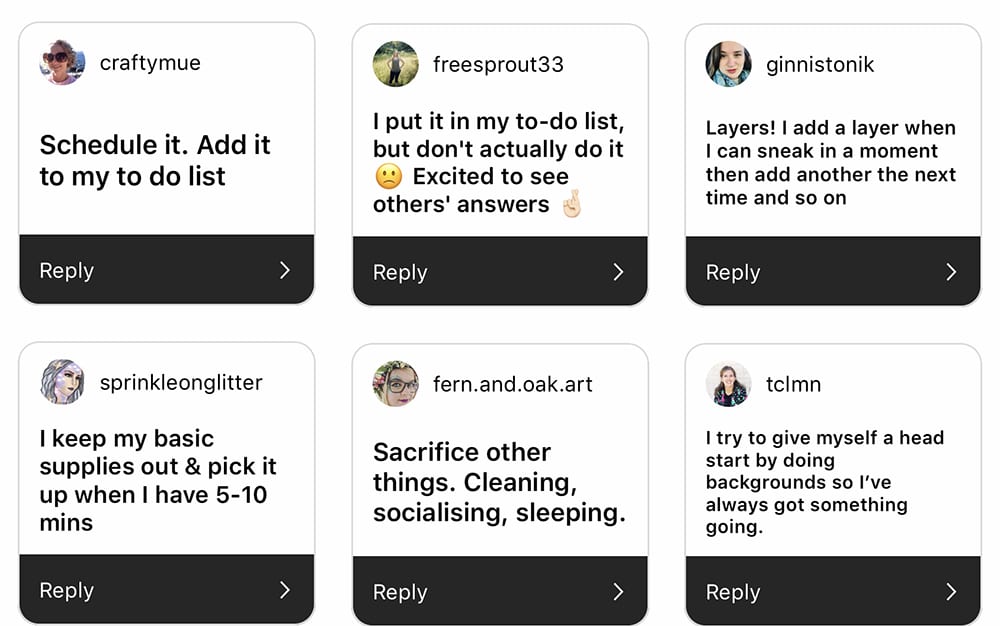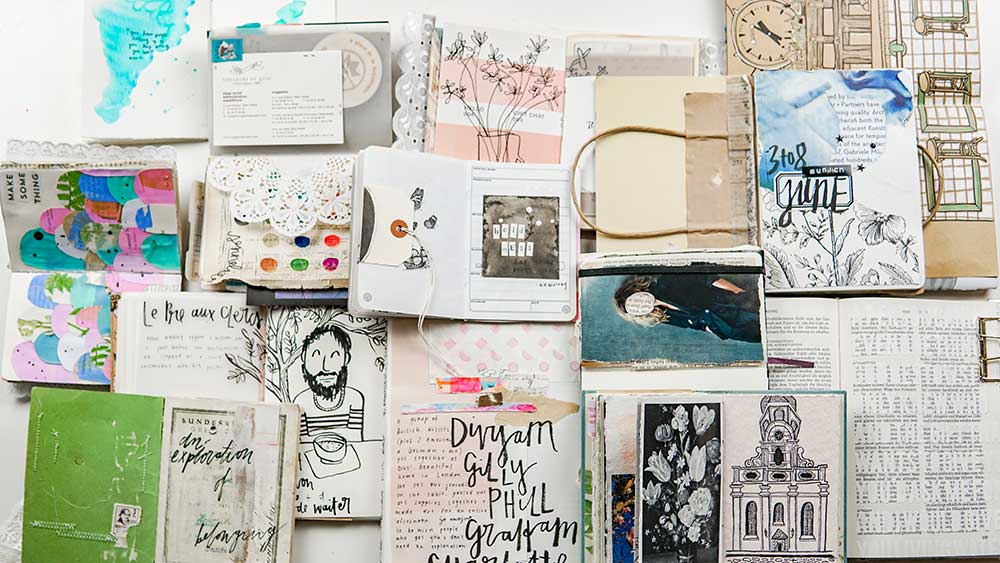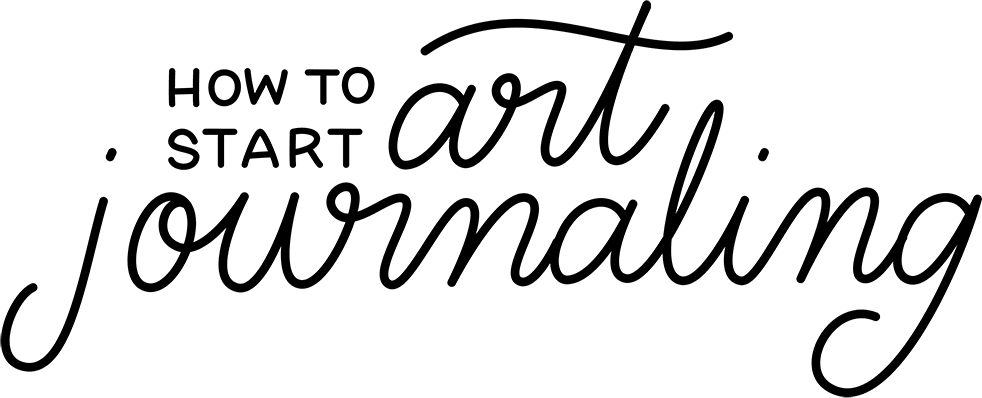- We love people who make art, and if you’re here then we love you too
- Lesson 1 – So what the Frida Kahlo is art journaling?
- Lesson 2 – It’s not about the tools, it’s about how you use them
- Lesson 3 – The breakfast of art journaling
- Lesson 4 – How to do the actionable inspiration thing
- Lesson 5 – Prompts are real life art catalysts
- Lesson 6 – Art friends are not like regular friends

How to start art journaling > Lesson 1
So what the frida Kahlo is Art Journaling?
Ah, the big question: What is art journaling?
It’s whatever you want it to be!
Wait, saying ‘whatever it is you want it to be’ didn’t answer your question? That’s strange 😉
In an effort to define this loose and manipulable term for you, first let us show you. Sometimes having a visual representation can help:
Art journaling is an ancient (we imagine, probably), secret (no longer, not sorry) practice that takes you from creative dreaming to creative DOING.
‘Cause let’s face it … those drips and spurts of creative inspiration aren’t helping you become the prolific artist you’re destined to be.
Which is where art journaling comes in. An art journal is a notebook that you fill with drawings, paintings, thoughts, words, lyrics, photos, magazine cut-outs and ephemera from your life.
It can have lots of words or no words. You can use it to document your life and express your emotions, or you can use it to practice art techniques that interest you.
But ultimately,
art journaling is all about creating for the sake of creating.
It’s powerful. It’s cathartic. It’s messy. It’s yours.
Or rather … it’s ours.
Now that we have defined art journaling, it is time for you to decide what you would like art journaling to be for you. But trust us, this definition will evolve. Take a moment and think about what you would like to learn from art journaling and why you want to art journal. Jot this down on a sticky note and put it up in your creative space. Let this be your guiding mantra as you begin this journey because as all great Jedis know, you can’t reach your destination if you don’t know where you are going.
What kind of human has time for this?
None of us has time. Not a single person in Get Messy has 10 uninterrupted hours per day to spend on her art. Funnily enough, we couldn’t even find one starving artist couped up in an attic surrounded by canvases when we surveyed our members.
Art journalers are people with crazy busy lives. They’re ruling the world in their own domains.
They find pockets of time for creating. They schedule time to create just like they schedule doctor appointments.
And, one of our favorite Messians, Rosie (@rosieraindrops), takes her art journal to the microwave to add a smear of paint as the seconds countdown. The freaking microwave.
Here are the ways in which art journalers find time to create:




Why art journal at all?
“If people knew how hard I worked to get my mastery, it wouldn’t seem so wonderful at all.”
– Michelangelo
ART JOURNALING ALLOWS YOU TO START FROM ZERO
The range of expertise for art journalers is wide. There are artists with a degree in fine art who sell their work in galleries making marks in a journal, and there are actual children scribbling on paper. You’re going to fall somewhere between those. There are art journalers who spend weeks on the same page, working on it for an hour a day, never quite feeling like it’s finished, and there are people who take five minutes and are done with the page. There are artists who use acrylic, watercolour, inks, pens, and collage on the same page, and there are those who simply use a pen.
You can do it your way.
Whatever your zero is, art journaling lets you start from there.
Whatever your journey is, art journaling allows it.
ART JOURNALING WILL GROW YOU AS AN ARTIST
You may think “I want to be an ARTIST” or “I want to make AMAZING things”. But then you sit down and have no idea what to make or what you do make is kind of terrible… or just, at least, not what you wanted to or expected. By this point in your adult life, you should know that you are not going to be amazing at something the first time you try a new thing. It’s easy to know, but tougher to know, so I’m going to say it again: you are not going to be amazing at something the first time you try it. You must practice, learn, mess up, try again and then practice some more. Just with any sport, musical instrument or simply the tying of shoes, practice and repetition are what grow our skills.
Whatever creative endeavors you would like to pursue, art journaling is how you will learn and practice for this. Art journaling allows you to test the waters, and develop what you like. It grows your art like crazy.
ART JOURNALING IS SELF CARE
Oh man. We love art journaling because it helps us process our thoughts. Very often, it helps us see what we are feeling before we knew we were feeling that. Art journaling expresses thought and emotion, whether through words or through art. For some people, regular journal writing is difficult to maintain. We might be bad at words, we might feel pressure to write like a professional novelist, or it might just not be very “me”.
There is so much that you can say without words and art journaling helps express it.
ART JOURNALING PUNCHES PERFECTION IN THE FACE
Perfectionism is a terrible thing that prevents us from releasing our beauty into the world, and even from starting. The more you art journal, the freer you are in your art because you’re not scared of sucking. For us personally, this “screw perfection” mentality has found its way into places other than our art journal.
If you make a page that you really don’t think reflects you, guess what? You just turn the page. Art journaling is creating for creation’s sake. Your art journal is a safe and forgiving place. A place without expectations and rules. A place that is private. It’s for you and nobody else unless you choose it.
Art journaling is pressure-free messing up. And we totally encourage messing up.
ART JOURNALING CREATES A HUGE BODY OF YOUR WORK
The beauty of art journaling is that it gets you from one streak of paint to one page to one finished journal to shelves full of your art journals. This body of work serves as a timeline. It shows how much you’ve grown as an artist. Our first art journals are completely different to our latest. Because of the nature of art journaling, it’s going to help you get as much art as possible made compared to creating art on a canvas or another medium.
If you work consistently at it, art journaling allows you to be prolific. You achieve quality through quantity.
ART JOURNALING PROMOTES CONSISTENCY AND HABIT
Magical things happen when you create consistently. Art journaling helps you to be consistently creative when you don’t have time to paint a human-sized detailed painting every day. And again, the dedication shown in the ease of art journaling will filter into the rest of your life and be glorious.
ART JOURNALING HELPS YOU FIND YOUR “STYLE”
A large body of work + consistent creating = your style. Almost everyone wants to find her style. Spoiler alert: you’re not going to find your style by pinning images with your favourite colours. You find your style by showing up and creating every single day (whether for five minutes or five hours). Art journaling is the place to try new things. It’s how you get to see what you like, and what you don’t. It allows you to use potatoes in your art, see that you love it, and develop it. You’re able to smear different paints on a page and choose which ones just didn’t work. Art journaling is a quicker way of discovering your style.
ART JOURNALING HAS A LOVELY COMMUNITY
Having people who get what you’re doing is invaluable. When you’re in a slump, they’re there to encourage. When you have a question, guess who’s there to help? We are yet to find a creative community as kind as art journaling. In the entire five year history of Get Messy, not once has someone shared their art and had a negative reply. That’s pretty amazing for something that happens through the internet.
We have been surprised so many times. Our least favourite pages, that we have shared anyway, have often received the most love. Having someone see something you’ve stared at for too long in a completely different light is truly encouraging. Art journalers are on this journey with you. They get you, they get why you’re doing this, and they are able to see its beauty.
Take a peek at our journals…
There are such a variety of ways to journal. All three of us have vastly different journaling styles. Have a look:

Vanessa
Going through my journals is like going back through time: the images and words are so very evocative. As you will see in the video, my journals really started out as visual diaries with lots of writing and the date added in. As my technique and style developed or changed, I moved away from this and let the spreads speak for themselves or hardly put any words at all.


Caylee
Here are some of my journals and a peek into one of them:

As for Amy’s? You’ll see her journals in the next lesson…
Action Steps
Define art journaling for yourself. We have told you what art journaling is to us and showed you some examples. So take a moment to jot down what your understanding of it is.
Set your intentions. We told you our why’s, so what are yours? Why do you want to art journal? What do you want to create? Learn? Why?
Create! Instead of just writing these on a piece of paper, make them into an art journal page! Add a doodle, a smear of paint, try fancy lettering, or glue in a piece of pretty paper in order to make it an art journal instead of just a journal. (remember – anything counts!)
